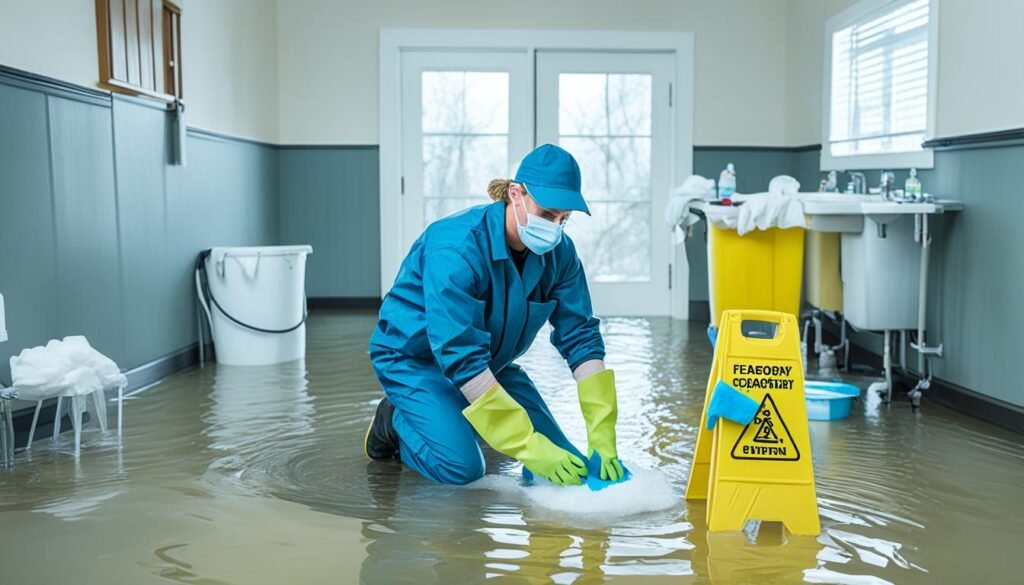Did you know acting quickly after a flood is very important? If you act fast, within the first 24 hours, you can lessen the damage water causes. This fast action helps avoid big problems with your house structure, stops mold, and saves your things from being ruined. Time is really important in fixing your home after a flood. Knowing how urgent this is helps you recover faster.
Key Takeaways:
- Prompt action within the first 24 hours after a flood is crucial for minimizing destructive consequences.
- Ensure everyone’s safety by turning off electrical sources and removing wet items.
- Have the right equipment for home flood restoration, including water extraction devices, moisture meters, dehumidifiers, and air movers.
- Understand water damage categories and restoration techniques for efficient restoration.
- Implement mold prevention strategies and navigate insurance claims for a smooth cleanup process.
Immediate Actions for Effective Flood Cleanup
It’s key to act fast after a flood to lessen further harm and ensure a safe, rapid recovery. Following certain steps will reduce water damage. This way, you can fix your home more efficiently.
Turn Off Utilities and Ensure Safety
Turning off utilities like electricity, gas, and water is critical to avoid electrical dangers. This ensures everyone’s safety during cleanup. It reduces risks and makes the environment safer for cleanup.
Promptly Report Maintenance Issues
Quickly tell maintenance about any flood-related issues. Report problems with the electrical system, plumbing, or HVAC units. Fixing these fast can stop more damage and speed up restoration.
Avoid Contact with Flood Waters
Stay away from flood waters to dodge contaminants and hazards. These waters may carry sewage, chemicals, or sharp objects. Always wear gloves and boots for safety.
Document the Damage
Taking pictures and making detailed notes of the damage is critical for insurance and legal reasons. This documentation supports your claim. It helps in getting the right compensation for repairs.
Take Mitigation Steps
Start removing water from your home quickly. Use pumps or wet vacuums for this. Also, to protect areas like basements, shut isolation valves. This prevents more water from coming in.
Establish Clear Communication Protocols
Good communication is crucial during flood cleanup. Make sure everyone knows how to report issues and the steps to follow if needed. Clear communication helps speed up restoration and avoids delays.
Utilize Email and Text for Maintenance Requests
Use email and text to report maintenance problems. This creates a written record. It makes sure requests are tracked and easily found later.
Consider Mobile Patrol Services
Mobile patrol services add extra security after a flood. They help in spotting issues early and ensuring on-site safety. This lessens the chance of damage and aids in insurance claims.
Enhance Security Measures for Insurance Discounts
Security steps, like mobile patrols, protect your place and may lower insurance costs. Insurance companies often give discounts for lower risks and recorded security actions.
Taking quick action helps manage flood damage well. It makes recovery smoother and lessens effects on your property.
Tips for Effective Flood Cleanup and Future Prevention
Act quickly when you find water damage. This stops mold and keeps the structure safe. First, see where the water is coming from and how bad it is. This helps you make a good cleanup plan.
Wear the right gear like gloves, goggles, and boots for protection. This keeps you safe from dirty water.
Get rid of all standing water right away. You can use pumps, wet vacuums, or towels. Make sure the water is thrown away properly. This stops it from spreading.
After removing the water, dry everything well. Use fans, dehumidifiers, and open windows to help. This stops mold from growing.
Clean and disinfect all surfaces to kill germs. Use the right cleaners and follow guidelines. This helps prevent more mold.
Finally, protect your home from future floods. Maybe change your yard’s slope. Improve your drains and use strong materials.
These steps help you recover quickly and lower future risks. Acting early is the best way to keep your home safe.


